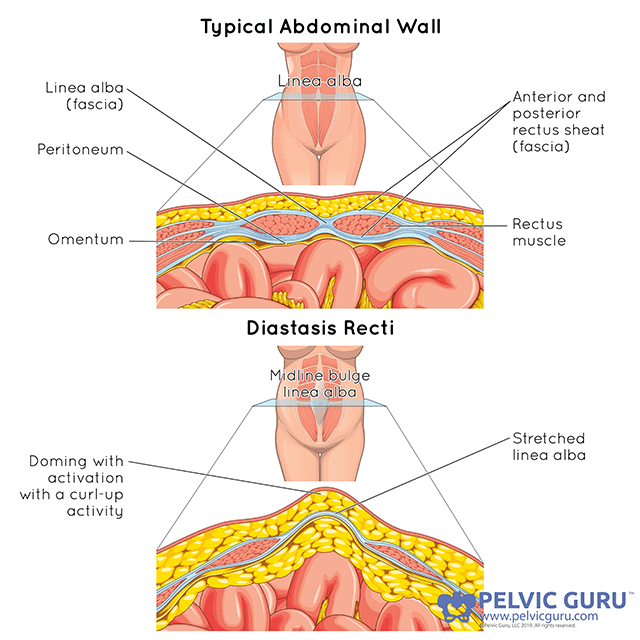Why didn't my rectus diastasis close on it's own?
Permission to use copyright image from Pelvic Guru, LLC
Rectus diastasis bulging with exercise (Permission to use copyright image from Pelvic Guru, LLC)
Before you read you make sure you check out my other related posts: what is rectus diastasis? and do I have rectus diastasis?
If you know what rectus diastasis is, and you have determined that you have a diastasis recti, then your next question will be
why me?
Why didn’t my abdominal muscles come back together on their own?
There are numerous reasons why your muscles may remain separated through the postpartum period.
Your muscles and brain are not communicating well
During pregnancy, your muscles were stretched to their maximum and the diastasis developed, your muscles stopped responding well when your brain asked them to contract. Eventually your brain may have given up. Why tell your abs to contract if they don’t respond anyway? Postpartum, your muscles need to be retrained on how to contract effectively to create tension through the linea alba, support your organs, give you trunk and spinal stability, and allow you to move with ease. You can retrain your muscles to contract by correctly performing abdominal exercises, but you need to do the right exercises with good form which includes the right engagement pattern. You also need to do exercises that are hard enough for you to get stronger and easy enough for you to do them correctly.
The connective tissue is stuck
The connective tissue of the linea alba is continuous with the connective tissue of the parietal peritoneum surrounding your abdominal organs. This connective tissue bunches together along your spine and then fans out over your small intestine. Where it normally bunches together along the spine is called the mesenteric root and the fan around the small intestine is the mesentery. This connective tissue can get stuck along the mesenteric root and in the mesentery. When this occurs, no amount of contracting your abs will unstick it. It is like trying to close a hole in pizza dough while someone is holding the crust parts to the edges of the pan. Visceral mobilization can unstick the connective tissue making it easier to bring the muscles together.
Your pelvic bones and therefore your Muscles, are not aligned well
The abdominal muscles are attached along the top of the pelvic bones. If these bones are asymmetrical, then the fibers that need to link together are at different heights. Even when you contract your muscles correctly, the two sides are not aligned to each other. They cannot come together. You need help to make sure your pelvis is in a neutral and symmetrical alignment so that your muscles can be aligned too.
Your rib cage is expanded
Your rib cage expands to make room for your baby, but it may not come back to it original size on its own. This expanded state makes it harder to breath well and harder to contract your abdominal muscles effectively. This means that your muscles do not contract effectively even when the brain sends the right signal.
Can it be fixed?
I also want to discuss that you can have some of these factors without having a significant abdominal separation. All of the above factors will make it harder to contract your abdominal muscles effectively and harder to stabilize your trunk as you complete tasks throughout your day. All of these factors can be improved with physical therapy at New Journey Physical Therapy. When I treat a client with diastasis recti, abdominal weakness, or poor activation patterns, then I treat all aspects. I want to make sure the body is set up to do its best healing.
Want to get started with physical therapy for diastasis recti? Read up on our options for postpartum physical therapy or book your consult now.

